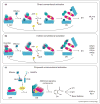A new eye on NLR proteins: focused on clarity or diffused by complexity?
- PMID: 22305607
- PMCID: PMC3482489
- DOI: 10.1016/j.coi.2011.12.006
A new eye on NLR proteins: focused on clarity or diffused by complexity?
Abstract
The nucleotide-binding domain leucine-rich repeat proteins (NLRs) represent the major class of intracellular innate immune receptors in plants and animals. Understanding their functions is a major challenge in immunology. This review highlights recent efforts toward elucidating NLR functions in human and plants. We compare unconventional aspects of NLR proteins across the two kingdoms. We review recent advances describing P-loop independent activation, nuclear-cytoplasmic trafficking, oligomerization and multimerization requirements for signaling, and for expanded functions beyond pathogen recognition by several NLR proteins.
Copyright © 2012 Elsevier Ltd. All rights reserved.
Figures



References
-
- Jones JD, Dangl JL. The plant immune system. Nature. 2006;444:323–329. - PubMed
-
- Segonzac C, Zipfel C. Activation of plant pattern-recognition receptors by bacteria. Curr Opin Microbiol. 2011;14:54–61. - PubMed
-
- Guo YL, Fitz J, Schneeberger K, Ossowski S, Cao J, Weigel D. Genome-wide comparison of NB-LRR encoding genes in Arabidopsis. Plant Physiol. 2011;157:757–769. The authors compared the repertoire of NLR proteins of Arabidopsis thaliana with its outcrossing relative A. lyrata and analyzed inter-specific and intra-specific diversity. - PMC - PubMed
Publication types
MeSH terms
Substances
Grants and funding
LinkOut - more resources
Full Text Sources

